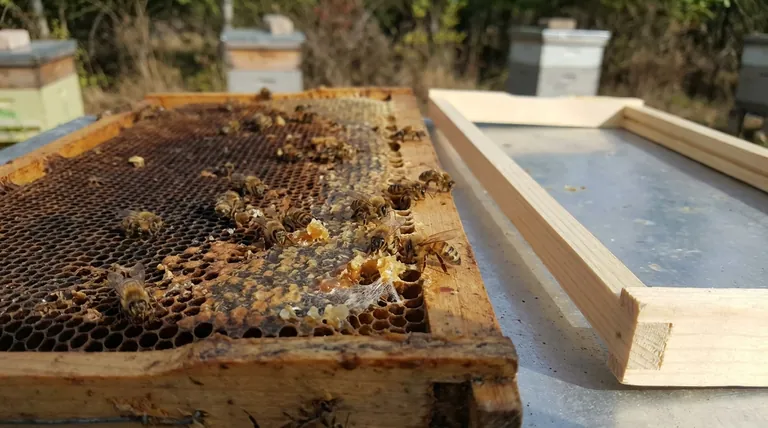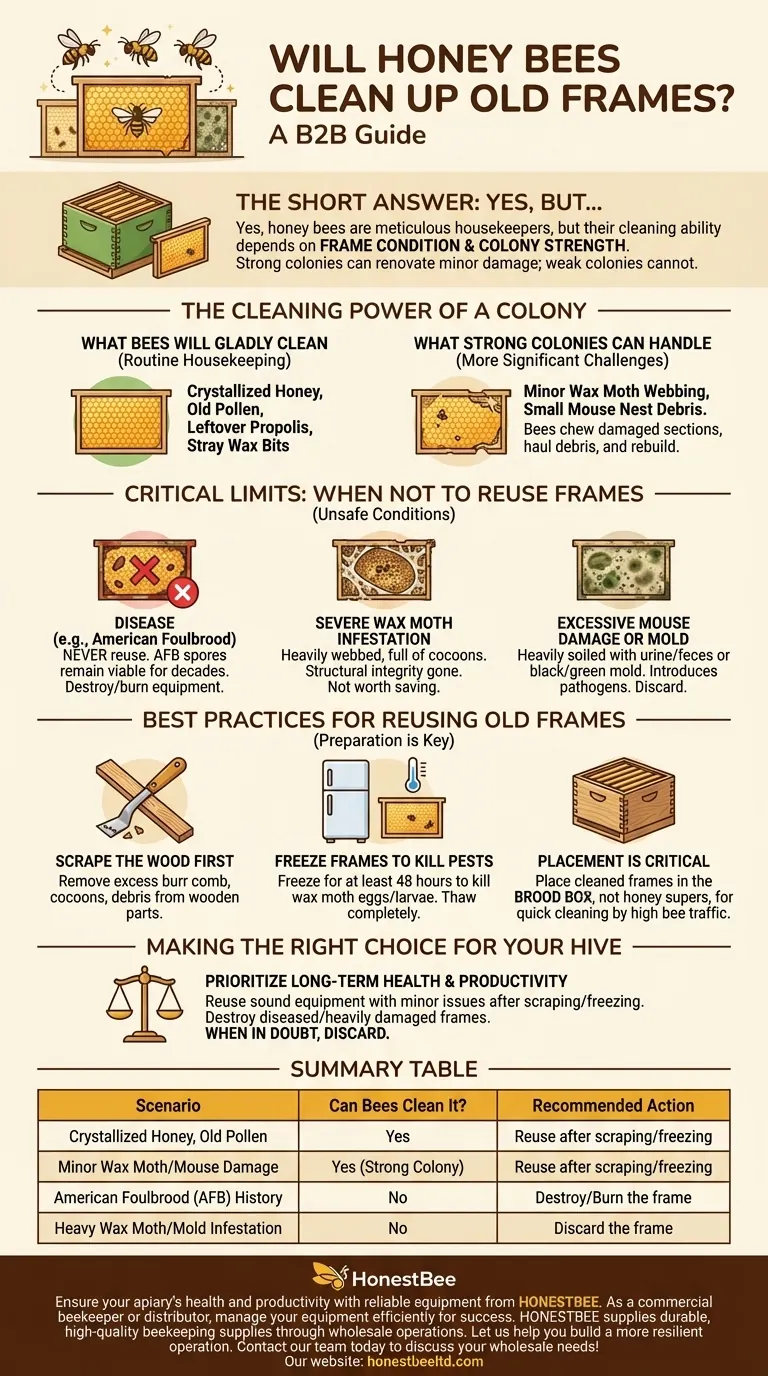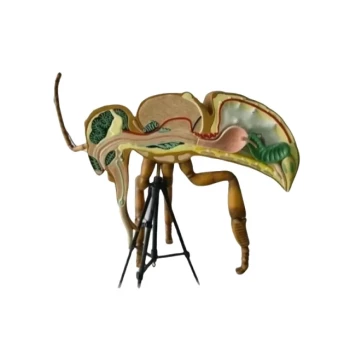Yes, honey bees are meticulous housekeepers and will clean up old comb and frames, but their ability to do so depends entirely on the condition of the frame and the strength of the colony. A strong, populous hive can renovate frames with minor damage from wax moths or mice, but they cannot and should not be expected to handle frames compromised by disease or heavy contamination.
Your role as a beekeeper is not just to provide equipment, but to ensure it's safe. While bees can clean many things, you must first determine if a frame is worth saving or if it poses a risk to the hive's health.

The Cleaning Power of a Colony
Honey bees are driven by instinct to maintain a hygienic and efficient nest. They will remove debris, repair damaged comb, and polish cells with propolis to prepare them for raising brood or storing resources.
What Bees Will Gladly Clean
A healthy colony will readily clean frames containing crystallized honey, old pollen, leftover propolis, and bits of stray wax. This is part of their routine housekeeping, and they are exceptionally good at recycling these resources.
What Strong Colonies Can Handle
A powerful, thriving colony has the workforce to tackle more significant challenges. They can often manage frames with minor wax moth webbing or a small amount of debris from a winter mouse nest. The bees will chew away the damaged sections, haul out the debris, and rebuild the wax.
Critical Limits: When Not to Reuse Frames
Reusing frames is efficient, but it carries risks. Certain conditions make a frame unsafe and a liability to your apiary. Your judgment is the most critical factor.
The Absolute Non-Negotiable: Disease
Never, under any circumstances, reuse frames from a colony that died from a known disease like American Foulbrood (AFB) or from an unknown cause. AFB spores can remain viable in old equipment for decades, and introducing a contaminated frame will infect and destroy the new colony. This equipment should be burned or disposed of according to local apiary regulations.
Severe Wax Moth Infestation
While bees can handle a few wax moth tunnels, a frame that is heavily webbed, full of cocoons, and falling apart is not worth saving. The structural integrity of the comb is gone, and it would take the bees more energy to clean and repair than to draw a fresh frame.
Excessive Mouse Damage or Mold
If a frame is heavily soiled with mouse urine and feces or covered in significant black or green mold, it should be discarded. These contaminants can introduce pathogens into the hive. While bees can clean a minor spot, a saturated frame presents an unnecessary health risk.
Best Practices for Reusing Old Frames
If you've determined a frame is salvageable, a little prep work on your part will help the bees and protect the hive.
Scrape the Wood First
Before giving a frame to the bees, use your hive tool to scrape off any excess burr comb, old cocoons, and visible debris from the wooden parts. This gives the bees a clean start.
Freeze Frames to Kill Pests
The single best practice is to freeze the frames for at least 48 hours. This will kill any existing wax moth eggs and larvae. Thaw the frames completely before placing them in the hive to prevent chilling the brood.
Placement is Critical
Place cleaned, salvaged frames in the brood box, not the honey supers. The high bee traffic in the brood nest ensures the frames will be cleaned and repaired quickly. Never place questionable frames in supers where honey for human consumption will be stored.
Making the Right Choice for Your Hive
Your decision to reuse or discard a frame should always prioritize the long-term health and productivity of your colony.
- If your primary focus is saving sound equipment: Reuse frames with old honey, pollen, or minor pest damage after you scrape and freeze them.
- If your primary focus is hive health and safety: Immediately destroy any frames from diseased colonies or those with heavy mold or excessive mouse contamination.
- If you are ever in doubt about a frame's history: The safest choice is always to discard it and provide the bees with a fresh, clean foundation.
Trusting your bees' instincts while respecting their limits is the mark of a responsible and successful beekeeper.
Summary Table:
| Scenario | Can Bees Clean It? | Recommended Action |
|---|---|---|
| Crystallized Honey, Old Pollen | Yes | Reuse after scraping/freezing |
| Minor Wax Moth/Mouse Damage | Yes (Strong Colony) | Reuse after scraping/freezing |
| American Foulbrood (AFB) History | No | Destroy/Burn the frame |
| Heavy Wax Moth/Mold Infestation | No | Discard the frame |
Ensure your apiary's health and productivity with reliable equipment from HONESTBEE.
As a commercial beekeeper or distributor, managing your equipment efficiently is key to your success. HONESTBEE supplies durable, high-quality beekeeping supplies and equipment through wholesale-focused operations, helping you maintain strong, healthy hives.
Let us help you build a more resilient and profitable operation. Contact our team today to discuss your wholesale needs!
Visual Guide

Related Products
- Wooden Bee Hive Frames for Beekeeping and Wholesale
- Copper Bee Frame Eyelets for Beekeeping
- HONESTBEE Bee Frame Grooving Machine | Precision Slotting for Bee Frame Making
- Australian Pine Wood Langstroth Screen Bottom Board for Wholesale
- Professional Galvanized Hive Strap with Secure Locking Buckle for Beekeeping
People Also Ask
- What are the primary uses of different Langstroth frame sizes? Optimize Your Hive for Health & Honey
- What parts of bee equipment should not be painted? Protect Your Hive's Interior for Bee Health
- When should bee frames be thrown away? A Beekeeper's Guide to Hive Health & Biosecurity
- What is the recommended number of frames for a beginner beekeeper? The Essential Rule for a Healthy Hive
- What are the standard sizes of frames used in Langstroth hives? Choose the Right Frame for Your Apiary



















